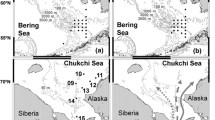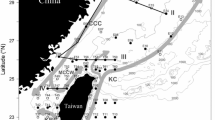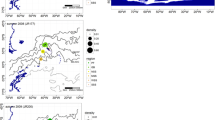Abstract
Monitoring of early euphausiid larvae provides valuable information on the mechanisms involved in recruitment to the adult populations. As the Antarctic is undergoing rapid environmental change, these mechanisms are key to ecosystem-based management of the krill fishery. We analyzed the distribution and abundance of early euphausiid larvae (calyptopes I to late furciliae) from 76 plankton samples from surface to 300 m depth in the Atlantic sector in January 2011 in relation with a previous survey and published information. Thysanoessa macrura (mean density: 209 ind m−2) dominated the sampling while Euphausia superba (mean density: 13.63 ind m−2) and Euphausia frigida (mean density: 10.05 ind m−2) were also present. T. macrura density increased while E. superba experienced a high decrease respect to historical data. Clustering of stations and correspondence analysis showed that the associations of larvae and water masses are in agreement with literature reports, so the differences on the abundance of early larvae are within the observed variability and cannot be attributed to any single factor, suggesting that it is due to more subtle changes such as the stability of the water column and/or vorticity in the fronts.






Similar content being viewed by others
References
Boning CW, Dispert A, Visbeck M, Rintoul SR, Schwarzkopf FU (2008) The response of the Antarctic Circumpolar Current to recent climate change. Nat Geosci 1:864–869. https://doi.org/10.1038/ngeo362
Brinton E, Towsend A (1984) Regional relationship between development and growth in larvae of Antarctic krill, Euphausia superba, from field samples. J Crustacean Biol 5:224–246
Brinton E, Huntley M, Townsend AW (1986) Larvae of Euphausia superba in the Scotia Sea and Bransfield Strait in March 1984 – development and abundance compared with 1981 larvae. Polar Biol 5:221–234
Clarke KR, Gorley RN (2015) PRIMER v7: user manual/tutorial. Plymouth: PRIMER-E. http://updates.primer-e.com/primer7/manuals/User_manual_v7a.pdf
Chapman CC, Lea MA, Meyer A, Sallée JB, Hindell M (2020) Defining Southern Ocean fronts and their influence on biological and physical processes in a changing climate. Nat Clim Change. https://doi.org/10.1038/s41558-020-0705-4
de Baker AC (1965) The latitudinal distribution of Euphausia species in the surface waters of the Indian ocean. Dis Rep 33:309–334
Deacon GER (1937) The hydrology of the southern ocean. Discovery Rep 15, Cambridge Univ. Press
Deacon GER (1979) The Weddell Gyre. Deep Sea Res 26:981–998
Dietrich K, Brooks C, Bystrom I, Driscoll R, Ferm N, Hinke J, Janssen M, Lombard D, Pesce A, Romain S,Thoresen L, van Cise A (2014) Distribution and catch rates of zooplankton around the South Shetland Islands, Antarctica. In: Walsh JG (ed) AMLR 2010–11 Field Season Report. NOAA-TM-NMFS-SWFSC-524: 18–27
Dotto TS, Kerr R, Mata MM, Garcia CAE (2016) Multidecadal freshening and lightening in the deep waters of the Bransfield Strait, Antarctica. J Geophys Res Oceans 121:1–16. https://doi.org/10.1002//2015JC011228
Fedotov AS (1992) Winter distribution of Euphausiid larvae in the Convergence Zone of the Antarctic Circumpolar Current and Weddell Sea Waters. Oceanology 32:191–196
Fisher EC, Kaufmann RS, Smith KL Jr (2004) Variability of epipelagic macrozooplankton/micronekton community structure in the NW Weddell Sea, Antarctica (1995–1996). Mar Biol 144:345–360. https://doi.org/10.1007/s00227-003-1177-6
Flores H, Atkinson A, Kawaguchi S, Krafft BA, Milinevsky G, Nicol S, Reiss C, Tarling GA, Werner R, Bravo Rebolledo E, Cirelli V, Cuzin-Roudy J, Fielding S, Groeneveld JJ, Haraldsson LA, Marschoff E, Meyer B, Pakhomov EA, Rombolá E, Schmidt K, Siegel V, Teschke M, Tonkes H, Toullec JY, Trathan PN, Tremblay N, Van de Putte AP, van Franeker JA, Werner T (2012) Impact of climate change on Antarctic krill. Mar Ecol Prog Ser 458:1–19. https://doi.org/10.3354/meps09831
Gao G, Xu Z, Huang H, Chen X, Feng Ch, Li L (2013) Geographical distribution and age composition of Euphausia superba larvae (Crustacea:Euphausiacea) in the South Shetland Islands region and southern Scotia Sea in relation to environmental conditions. Acta Oceanol Sin. https://doi.org/10.1007/s13131-013-0378-1
Gallotti DS (2013) Distribución de larvas de eufausiáceos en el extremo sur del Océano Atlántico. Tesis doctoral. Universidad de Buenos Aires 198 pp. http://digital.bl.fcen.uba.ar/download/tesis/tesis_n5390_Gallotti.pdf.
Hallberg R, Gnanadesikan A (2006) The role of Eddies in determining the structure and response of the wind-driven Southern Hemisphere overturning: results from the modeling Eddies in the Southern Ocean (MESO) project. J Phys Oceanogr. https://doi.org/10.1175/JPO2980.1
Haraldsson M, Siegel V (2014) Seasonal distribution and life history of Thysanoessa macrura (Euphausiacea Crustacea) in high latitude waters of the Lazarev Sea, Antarctica. Mar Ecol Prog Ser 495:105–118. https://doi.org/10.3354/meps10553
Hempel I, Hempel G (1978) Distribution of euphausiid larvae in the southern Weddell Sea. Meeresforsch 29:253–266
Hempel I, Marschoff E (1980) Euphausiid larvae in the Atlantic Sector of the Southern Ocean. Meeresforsch 28:32–47
Hempel I (1981) Euphausiid larvae in the Scotia Sea and adjacent waters in summer 1977/78. Meeresforch 29:53–59
Hempel I, Hempel G (1982) Distribution of euphausiid larvae in the southern Weddell Sea. Meeresforsch 29:253–266
Hempel I (1985a) Variation in Geographical Distribution and Abundance of Larvae of Antarctic Krill, Euphausia superba, in the Southern Atlantic Ocean. In: Condy PR, Laws RM, Siegfried WR (eds) Antarctic nutrient cycles and food webs. Springer, Berlin, Heidelberg, pp 304–307
Hempel I (1985b) Vertical distribution of Larvae of Antarctic Krill, Euphausia superba. In: Condy PR, Laws RM, Siegfried WR (eds) Antarctic nutrient cycles and food webs. Springer, Berlin, Heidelberg, pp 308–310
Heywood K, Naveira Garabato A, Stevens D, Muench M (2004) On the fate of the Antarctic Slope Front and the origin of the Weddell Front. J of Geophys Res 109(C06021):1–13. https://doi.org/10.1029/2003JC002053
Hoegh-Guldberg O, Bruno JF (2010) The impact of climate change on the World’s. Marine Ecosyst Sci 328:1523–1528. https://doi.org/10.1126/science.1189930
Hofmann EE, Capella JE, Ross RM, Quetin LB (1992) Models of the early life history of Euphausia superba. Part I. Time and temperature dependence during the descent-ascent cycle. Deep Sea Res 39:1177–1200
Ikeda T (1984) Development of thelarvae of the Antarctic krill (Euphausia superba Dana) observed in the laboratory. J Exp Mar Biol Ecol 75:107–117
John DD (1936) The Southern species of the genus Euphausia. Discovery Rep 14:193–324
Lebart L, Morineau A, Fenelon JP (1979) Traitement des données statistiques. Dunod, Methodes et Programmes Paris, p 441
Loeb VJ, Shulenberger E (1987) Vertical Distributions and relations of euphausiid populations off Elephant Island, March 1984. Polar Biol 7:363–373
Loeb VJ, Hofmann EE, Klinck JM, Holm-Hansen O, White WB (2009) ENSO and variability of the Antarctic Peninsula pelagic marine ecosystem. Antarct Sci 21:135–148. https://doi.org/10.1017/S0954102008001636
Loeb V, Hofmann EE, Klinck JM, Holm-Hansen O (2010) Hydrographic control of the marine ecosystem in the South Shetland-Elephant Island and Bransfield Strait region. Deep Sea Res II:519–542. https://doi.org/10.1016/j.dsr2.2009.10.004
Loeb V, Santora J (2015) Climate variability and spatio temporal dynamics of five Southern Ocean krill species. Prog Oceanogr 134:93–122. https://doi.org/10.1016/j.pocean.2015.01.002
Mackintosh NA (1973) Distribution of post-larval krill in the Antarctic. Discovery Rep 36:95–156
Makarov RR (1977) Larvae distribution and some aspects of the ecology of Euphausia frigida (Crustacea, Euphausiacea)in the South Scotia region. Okeanologiya 17:324–334
Makarov RR (1979a) Estadios larvales tempranos de los eufausiáceos antárticos. Zool Zhur 58:314–327
Makarov RR (1979b) Larval distribution and reproductive ecology of Thysanoessa macrura (Crustacea: Euphausiacea) in the Scotia Sea. Mar Biol 52:377–386
Makarov RR, Maslennikov VV (1981) Ecology of larval development of the Crustacean Euphausia superba. Change in dominant larvae forms as a function of environmental conditions. Mar Ecol Prog Ser 4:265–271
Makarov RR, Menshenina LL (1989) On the distribution of Euphausiid larvae in Antarctic waters. Oceanology 29:623–627
Makarov RR, Menshenina LL, Solyankin YV (1992) Euphausiid larvae in the Eastern Zone of the Weddell Gyre. Oceanology 32:186–190
Marr JWS (1962) The natural history and geography of the Antarctic Krill Euphausia superba. Discovery Rep 32:33–464
Marschall S, Mizdalzki E (1985) Euphausiid larvae in plankton samples from the vicinity of the Antarctic Peninsula, february 1982. Ber Polarforsch 21, 47 pp
Marschoff ER (1985) Profile analysis of Euphausia superba larvae vertical distribution in the Scotia Sea, related to time factor. Polar Biol 5:35–41. https://doi.org/10.1007/BF00446043
Marschoff ER (1996) Estrategias reproductivas de las especies de eufausiáceos australes como mecanismo regulador de la distribución. Universidad de Buenos Aires, Tesis doctoral
Marschoff E, Calcagno J, Amieiro P (1998) Diel variation in catches of Euphausia superba Dana 1854 early larvae: vertical migration or avoidance reaction? J Exp Mar Biol Ecol 228:107–115. https://doi.org/10.1016/S0022-0981(98)00012-4
Menshenina LL (1989) Dates of spawning of Antarctic euphausiids. SC-CAMLR-VIII/BG 24
Meredith MP, Hogg AM (2006) Circumpolar response of Southern Ocean eddy activity to a change in the Southern Annular Mode. Geophys Res Lett 33:L16608. https://doi.org/10.1029/2006GL026499
Meredith M, Meijers A, Naveira Garabato A, Brown P, Venables H, Abrahamsen P, Jullion L, Messias MJ (2015) Circulation, retention, and mixing of waters within the Weddell-Scotia Confluence, Southern Ocean: the role of stratified Taylor columns. J Geophys Res Oceans. https://doi.org/10.1002/2014JC010462
Meyer B, Atkinson A, Bernard KS, Brierley AS, Driscoll R, Hill SL, Marschoff E, Maschette D, Perry FA, Reiss CS, Rombolá E, Tarling GA, Thorpe SE, Trathan PN, Zhu G, Kawaguchi S (2020) Successful ecosystem-based management of Antarctic krill should address uncertainties in krill recruitment, behaviour and ecological adaptation. Commun Earth Environ 1:28. https://doi.org/10.1038/s43247-020-00026-1
Morrison DF (1976) Multivariate statistical methods. Mc Graw Hill series in probability and statistics, Kogakusha, Tokyo, p 415
Motoda S (1959) Devices of simple plankton apparatus. Mem Fac Fish, Hokkaido Univ, 7: 73–94. http://hdl.handle.net/2115/21829. http://hdl.handle.net/2115/21829.
Nordhausen W (1992) Distribution and growth of larval and adult Thysanoessa macrura (Euphausiacea) in the Bransfield Strait region, Antarctica. Mar Ecol Prog Ser 83:185–196
Orsi AH, Whitworth T, Nowlin WD (1995) On the meridional extent and fronts of the Antarctic Circumpolar Current. Deep Sea Res I 42:641–673. https://doi.org/10.1016/0967-0637(95)00021-W
Patterson SL, Sievers HA (1980) The Weddell-Scotia Confluence. J of Phys Oceanog 10:1584–1610
Pertzova KN (1976) Larvae of Euphausiacea of the Antarctica Trudy. Inst Okeanol 105:147–170 (in Russian)
Ponomareva LA, Drobyisheva TV (1978) Euphausiids of the Australian-New Zealand region and nearby waters of Subantarctic. Akad Nauk SSSR 112:111–117 (in Russian)
Quetin LB, Ross RM (1984) Depth distribution of developing Euphausia superba embryos, predicted from sinking rates. Mar Biol 79:47–56
Quetin LB, Ross RM (1989) Effects of oxygen, temperature and age on the metabolic rate of the embryos and early larval stages of the Antarctic krill Euphausia superba Dana. J Exp Mar Biol Ecol 125:43–62
Rakusa-Suszczewski S (1984) Krill larvae in the Atlantic sector of the Southern Ocean during FIBEX 1981. Polar Biol 3:141–147
Rignot ES, Jacobs S, Mouginot J, Scheuchl B (2013) Ice-shelf melting around Antarctica. Science 341:266–270. https://doi.org/10.1126/science.123579
Rombolá EF, Franzosi CA, Tosonotto GV, Alder VA, Marschoff ER (2019) Variability of euphausiid larvae densities during summer seasons 2011, 2012 and 2014 in the Atlantic sector of the Antarctic. Polar Sci 19:86–93. https://doi.org/10.1016/j.polar.2018.11.004
Ross RM, Quetin LB, Kirsch E (1988) Effect of temperature on developmental times and survival of early larval stages of Euphausia superba Dana. J Exp Mar Biol Ecol 121:55–71
Saba GK, Fraser WR, Saba VS, Iannuzzi RA, Coleman KE, Doney SC, Ducklow HW, Martinson DG, Miles TN, Patterson-Fraser DL, Stammerjohn SH, Steinberg DK, Schofield OM (2014) Winter and spring controls on the summer food web of the coastal West Antarctic Peninsula. Nat Commun 5:4318. https://doi.org/10.1038/ncomms5318
SC-CAMLR (2014) Report of the working group on ecosystem monitoring and management. In: Report of the Thirty-three Meeting of the Scientific Committee (SC-CAMLR-XXXVI), Annex 6. CCAMLR, Hobart, Australia.
Setubal Pires AM (1986) Vertical distribution of Euphausiid Larvae (Crustacea) in the Brandfield Strait during the first Brazilian Antarctic Expedition (Summer 1982/83). An Acad Brasil Cienc 58:43–51
Siegel V (2000) Krill (Euphausiacea) life history and aspects of population dynamics. Can J Fish Aquat Sci 57:130–150. https://doi.org/10.1139/f00-183
Siegel V, Kawaguchi S, Ward P, Litvinov F, Sushin V, Loeb V, Watkins J (2004) Krill demography and large-scale distribution in the southwest Atlantic during January/February 2000. Deep Sea Res II 51:1253–1273. https://doi.org/10.1016/j.dsr2.2004.06.013
Siegel V, Reiss CS, Dietrich KS, Haraldsson M, Rohardt G (2013) Distribution and abundance of Antarctic krill (Euphausia superba) along the Antarctic Peninsula. Deep Sea Res I:63–74. https://doi.org/10.1016/j.dsr.2013.02.005
Siegel V, Watkins JL (2016) Distribution biomass and demography of Antarctic krill Euphausia superba. In: Siegel V (ed) Biology and Ecology of Antarctic Krill. Springer, Cham
Stupnikova AN, Tarakanov RY, Kulagin DN, Vereshchaka AL (2018) Factors maintaining the identity of mesoplankton communities: cool evidence from the Drake Passage. Hydrobiologia 809:221–232. https://doi.org/10.1007/s10750-017-3474-y
Tattersall WM (1924) Crustacea VIII: Euphausiacea. British Antarctic (Terra Nova) Expedition 1910. Nat Hist Rep Zoology 1:1–36
Thompson AF, Youngs MK (2013) Surface exchange between the Weddell and Scotia Seas. Geophys Res Lett 40:5990–5995. https://doi.org/10.1002/2013GL058114
Tranter DJ (1968) Smaller meso zooplankton. Report of Working Party N 2. In: Standarization of zooplankton sampling methods at sea. Zooplankton Sampling, Unesco
Tynan CT (1998) Ecological importance of the Southern Boundary of the Antarctic Circumpolar Current. Nature 392:708–710
Turner J, Bindschadler RA, Convey P, Di Prisco G, Fahrbach E, Gutt J, Hodgson DA, Mayewski PA, Summerhayes CP (2009) Antarctic climate change and the environment. SCAR, Cambridge, UK
Whitworth T III, Nowlin WD Jr, Orsi AH, Locarnini RA, Smith SG (1994) Weddell Sea shelf water in the Bransfield Strait and Weddell-Scotia Confluence. Deep Sea Res I 41:629–641
Venables H, Meredith M, Atkinson A, Ward P (2012) Fronts and Habitat zones in the Scotia Sea. Deep Sea Res II 59–60:14–24. https://doi.org/10.1016/j.dsr2.2011.08.012
Weber LH, El-Sayed SZ, Hampton I (1986) The variance spectra of phytoplankton, krill and water temperature in the Antarctic Ocean south of Africa. Deep Sea Res 33:1327–1343
Acknowledgements
We wish to thank members of Puerto Deseado Oceanographic vessel and scientists from Instituto Antártico Argentino for their logistic help during the campaign. The financial support was partially covered by PICTO 118-2010 (Agencia Nacional de Promoción Científica y Tecnológica) and Instituto Antártico Argentino, the Dirección Nacional del Antártico provided the logistic support of the campaign. We wish to thank reviewer #3 M Hamame and the other anonymous referees for comments that greatly improved the paper.
Author information
Authors and Affiliations
Contributions
All authors made contributions to the present work. The conception of the study was designed by EM. Material preparation and data collection were performed by ER, EM, SV and CF. Data analysis were performed by EM and ER. Figures were designed by CF and VA; GT made de oceanographic analysis from the CTD data. Logistic support for the campaign by SV. ER and EM wrote the manuscript, which was revised by all authors. All authors read and approved the final manuscript.
Corresponding author
Ethics declarations
Conflict of interest
The authors declare that no conflicts of interest exist. Procedures used in this study comply with the current laws for working in Antarctica. Permission to work was granted by the Environmental Management and Tourism Program of the Dirección Nacional del Antártico (DNA), Argentina.
Additional information
Publisher's Note
Springer Nature remains neutral with regard to jurisdictional claims in published maps and institutional affiliations.
Rights and permissions
About this article
Cite this article
E., R., C., F., G., T. et al. Density and distribution of euphausiid larvae in the Scotia Sea in the 2011 summer. Polar Biol 44, 783–794 (2021). https://doi.org/10.1007/s00300-021-02836-1
Received:
Revised:
Accepted:
Published:
Issue Date:
DOI: https://doi.org/10.1007/s00300-021-02836-1




